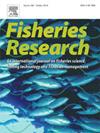Interactions and spatiotemporal variations in the life history attributes of a non-native species in the upper Paraná River and its native congener
IF 2.3
2区 农林科学
Q2 FISHERIES
引用次数: 0
Abstract
The introduction of species has negative effects on biodiversity and ecosystem functioning, with these impacts typically mediated by interspecific relationships. This study aimed to assess intraspecific and interspecific interactions, the effect of flood duration on the abundance of the congeners Megaleporinus piavussu (native) and M. macrocephalus (non-native), as well as variations in life-history traits across temporal scale for native species (pre- and post-invasion) and spatial scale for the non-native species (original and invaded environment). We tested the interaction effects between both species in population dynamics models. In contrast, life-history traits estimates for both species were obtained using length-frequency. The significant intraspecific competition coefficient suggests a negative impact on the annual per capita growth rate of both species. Only the native species population exhibited a significant interspecific competition coefficient. Flood duration positively affected the growth rate of both species, with more pronounced effects on the population of M. piavussu. During coexistence periods of the species (post-invasion period and invaded environments), a higher mean condition factor, female dominance, asymptotic length, longevity, and total mortality, including fishing mortality, were registered. On the other hand, the pre-invasion period for M. piavussu and the original environment for M. macrocephalus showed numerically lower values for life-history traits. Our findings suggest that the impact of the interspecific competition coefficient may be more pronounced for native species than for non-native species. Furthermore, the life history attributes of these species varied between the evaluated periods and locations in response to environmental conditions and food resource availability.
巴拉那河上游及其本地同系物非本地物种生活史属性的相互作用和时空变化
物种引入对生物多样性和生态系统功能具有负面影响,这些影响通常由种间关系介导。本研究旨在评估种内和种间相互作用,洪水持续时间对同源物种piavussu(本地)和M. macrocephalus(非本地)丰度的影响,以及本地物种(入侵前和入侵后)和非本地物种(原始环境和入侵环境)的生活史特征在时间尺度上的变化。我们在种群动态模型中测试了两种物种之间的相互作用效应。相比之下,这两个物种的生活史特征估计是使用长度-频率获得的。种内竞争系数显著,对两种的年人均生长率均有负向影响。只有本地种种群表现出显著的种间竞争系数。洪水持续时间对两种植物的生长率均有正向影响,其中对黄松种群的影响更为显著。在物种共存时期(入侵后和入侵环境),平均条件因子、雌性优势、渐近长度、寿命和总死亡率(包括捕捞死亡率)均较高。另一方面,piavussu的入侵前时期和大头m的原始环境在生活史性状上表现出较低的数值。我们的研究结果表明,种间竞争系数对本地物种的影响可能比对非本地物种的影响更为明显。此外,这些物种的生活史属性因环境条件和食物资源的可用性而在评估时期和地点之间发生变化。
本文章由计算机程序翻译,如有差异,请以英文原文为准。
求助全文
约1分钟内获得全文
求助全文
来源期刊

Fisheries Research
农林科学-渔业
CiteScore
4.50
自引率
16.70%
发文量
294
审稿时长
15 weeks
期刊介绍:
This journal provides an international forum for the publication of papers in the areas of fisheries science, fishing technology, fisheries management and relevant socio-economics. The scope covers fisheries in salt, brackish and freshwater systems, and all aspects of associated ecology, environmental aspects of fisheries, and economics. Both theoretical and practical papers are acceptable, including laboratory and field experimental studies relevant to fisheries. Papers on the conservation of exploitable living resources are welcome. Review and Viewpoint articles are also published. As the specified areas inevitably impinge on and interrelate with each other, the approach of the journal is multidisciplinary, and authors are encouraged to emphasise the relevance of their own work to that of other disciplines. The journal is intended for fisheries scientists, biological oceanographers, gear technologists, economists, managers, administrators, policy makers and legislators.
 求助内容:
求助内容: 应助结果提醒方式:
应助结果提醒方式:


